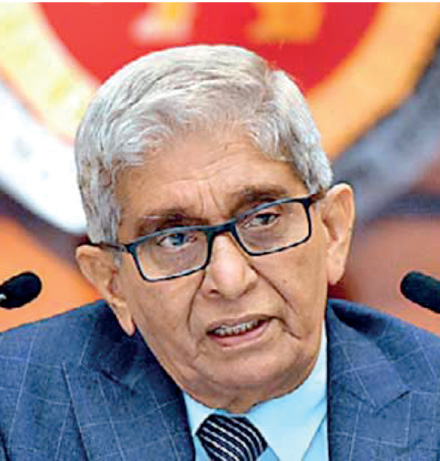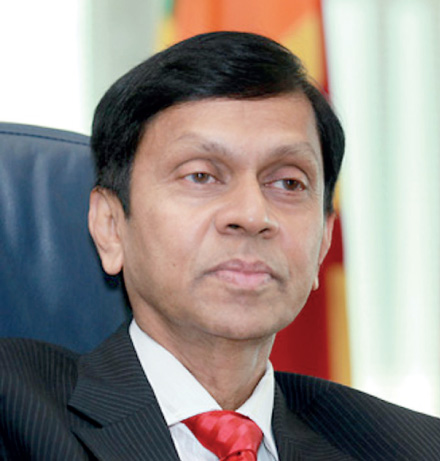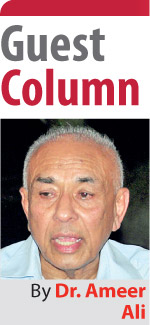Friday Jan 02, 2026
Friday Jan 02, 2026
Wednesday, 15 September 2021 00:00 - - {{hitsCtrl.values.hits}}

Professor W.D. Lakshman was the chief designer of President Gotabaya Rajapaksa’s ‘Viyath Maga’

Nivard Cabraal was the main brain behind President Mahinda Rajapaksa’s ‘Mahinda Chinthanaya’
 It was in 1962 that Prof. H. A. de S. Gunasekera published his book, ‘From Dependent Currency to Central Banking in Ceylon’. If someone were to write a sequel to that book today, the author may have to add at least a whole chapter with the title, ‘From Central Banking to Presidential Banking’.
It was in 1962 that Prof. H. A. de S. Gunasekera published his book, ‘From Dependent Currency to Central Banking in Ceylon’. If someone were to write a sequel to that book today, the author may have to add at least a whole chapter with the title, ‘From Central Banking to Presidential Banking’.
From the time CBSL was established in 1950 it has remained a statutorily empowered independent institution, until Professor W.D. Lakshman was handpicked by President GR and appointed as the bank’s Governor in December 2019. It was GR’s golden handshake to a professor who was the chief architect behind the President’s viethmaga and grand vision of an “alternate way” to achieve “prosperity and splendour”.
The fact that by 2019, Lakshman, like several of his academic colleagues at Peradeniya, had embraced the ideology of Sinhala Buddhist ethno-nationalism, made GR’s choice politically appropriate. However, with this appointment and removal of a couple of members of the then monetary board, to be replaced with the President’s favourites, and with clear instruction to all of them to assist implementing GR’s economic policies, the foremost economic institution of Sri Lanka, which remained independent until then became a tool in the hands of an executive president.
Although in theory central banks are known as government’s bank, what happened in Sri Lanka after 2019 was to turn CBSL virtually into a President’s monetary tool. This change is not dissimilar to what happened to another institution in the country, the Supreme Court.
The theoretical independence of a central bank does not mean that it could adopt a set of monetary policies totally in contradiction to the economic ideology and policies of ruling governments, even though there may be occasions when a central bank may be compelled to take that stand in order to inject some shock treatment to an economy inflicted by irrational fiscal policies.
Even in mega economies like those of US and EU for example, the ideology of central bank independence has come under constant criticism recently. According to one commentator, central bank independence is “a tired anachronism based on dubious economics”, and it should “broaden” its policy making in order to “improve our society” and protect “the future of our planet”.
In many emerging economies therefore, there is increasing strategic coordination between monetary and fiscal policies. However, in broadening the reach of central bank policy making the bank must be subjected to democratic accountability and political oversight.
With Sri Lanka’s executive presidency falling under an authoritarian schooled by the military, that accountability has been lost. Under Lakshman’s governorship CBSL simply became a money printer to provide liquidity to an economy hit by a pandemic caused worldwide depression worsened by a regime of fiscal policy born out of thought bubbles from a megalomaniac President.
On a wider canvas, the resignation of Lakshman comes after similar resignation of medical experts and epidemiologists who were frustrated by a regime’s unwillingness to entertain independent thinking and expert advice. There seems to be a culture of irreverence to rational thought within the ruling political circle.
That said, the replacement of Lakshman, an economist, by Ajith Nivard Cabraal, an accountant and politician, as the 16th Governor of CBSL does not augur well to improve the image and role of CBSL. Just as Lakshman was the chief designer of GR’s viethmaga, so was Cabraal who was the chief brain behind ‘Mahinda Chinthanaya’. He was an economic advisor of the Government during MR’s Presidency.
His record as previous governor is also not clean, and the saga of the Greek bond disaster masterminded by Cabraal is still fresh within the financial community. Therefore, how independently CBSL and its Monetary Board would function under Cabraal, and ignore pressures from the President’s office is not clear. In all probability CBSL Monetary Board may act as rubber stamp to decisions made personally between Cabraal and GR. Why then the need for a Monetary Board at all?
Cabraal was the man who continued to resist approaching IMF for assistance. Now he seems to be singing a different tune. Yet, IMF help comes with conditions attached to it. Will he advice the Government to accept those conditions, which would certainly force changes in the current fiscal regime?
Import restrictions endorsed by Lakshman’s regime may help conserve foreign exchange in the short run, but will lose more in the long run if foreign exporters respond by cutting their imports from Sri Lanka. Sri Lankan exports are also threatened by difficulties emanating from the Government’s foreign policy. The EU’s threat of withdrawing GSP is one example of that and if that eventuates EU will kill the nation’s apparel industry. The aftermath of the current UNHCR session in Geneva will probably carry more bad news to the economy.
The CBSL has therefore a very critical role to play in the current economic environment. Its monetary policy has to help primarily to reduce the punishing the cost of living at home while improving the nation’s external financial stability. This is a difficult task to achieve and needs creative and independent thinking which is not possible when the head of the institution is a politician attached to the ruling regime.
(The writer is attached to the School of Business & Governance, Murdoch University, Western Australia.)